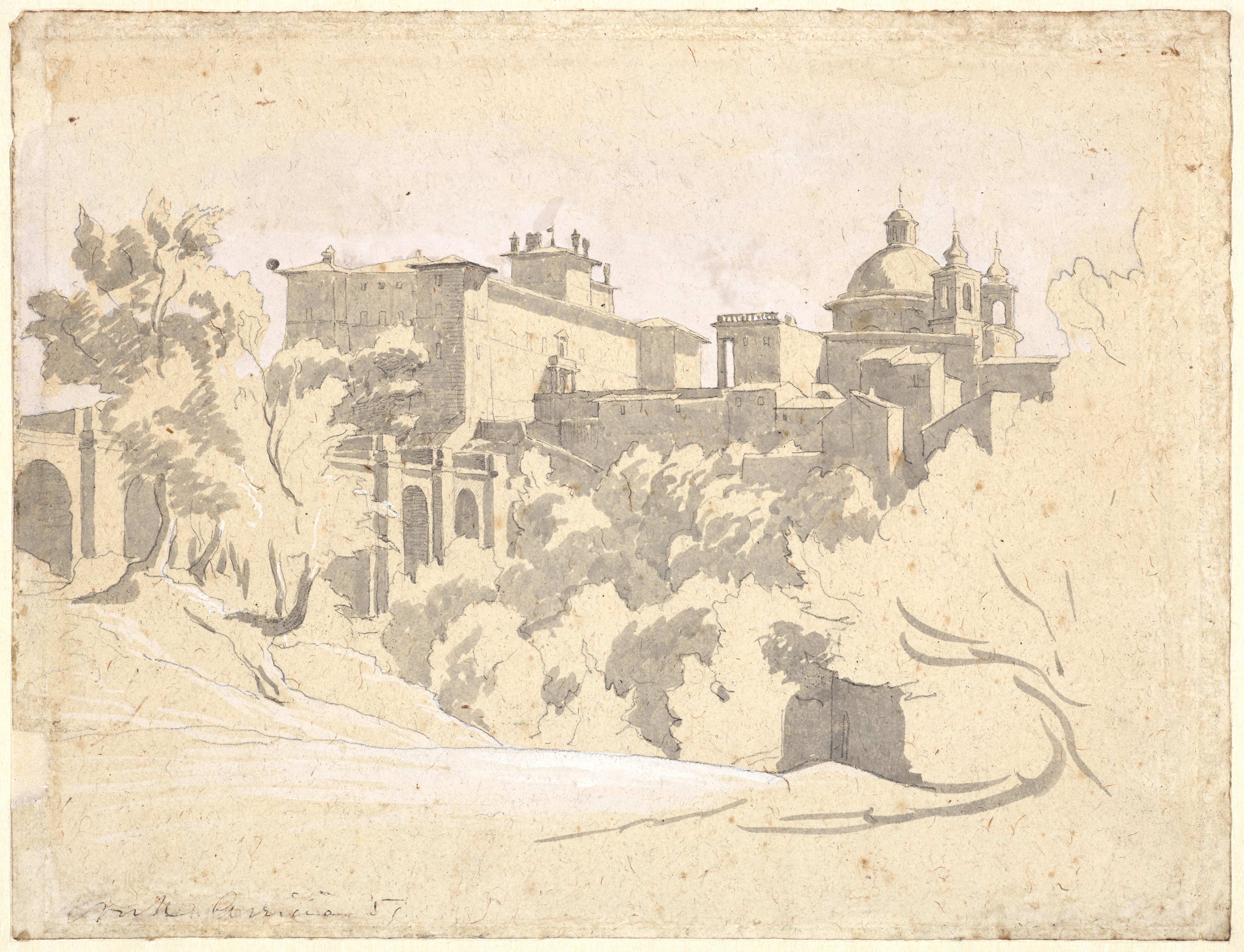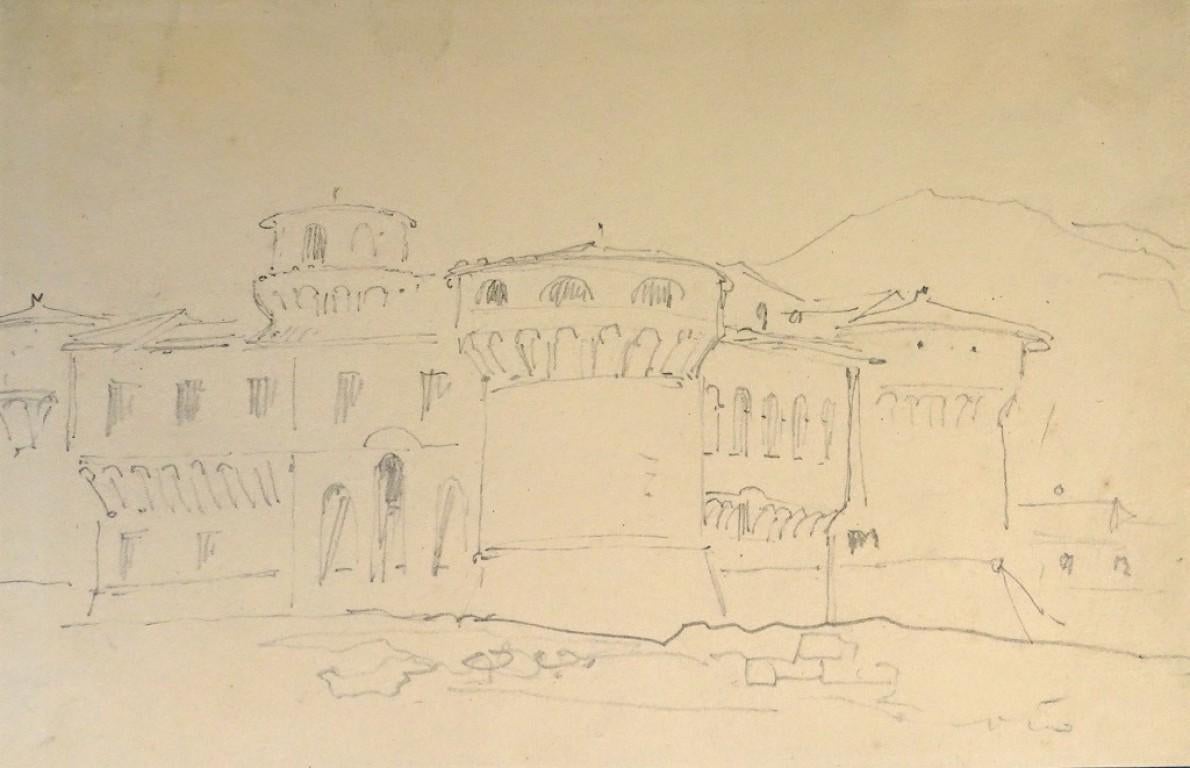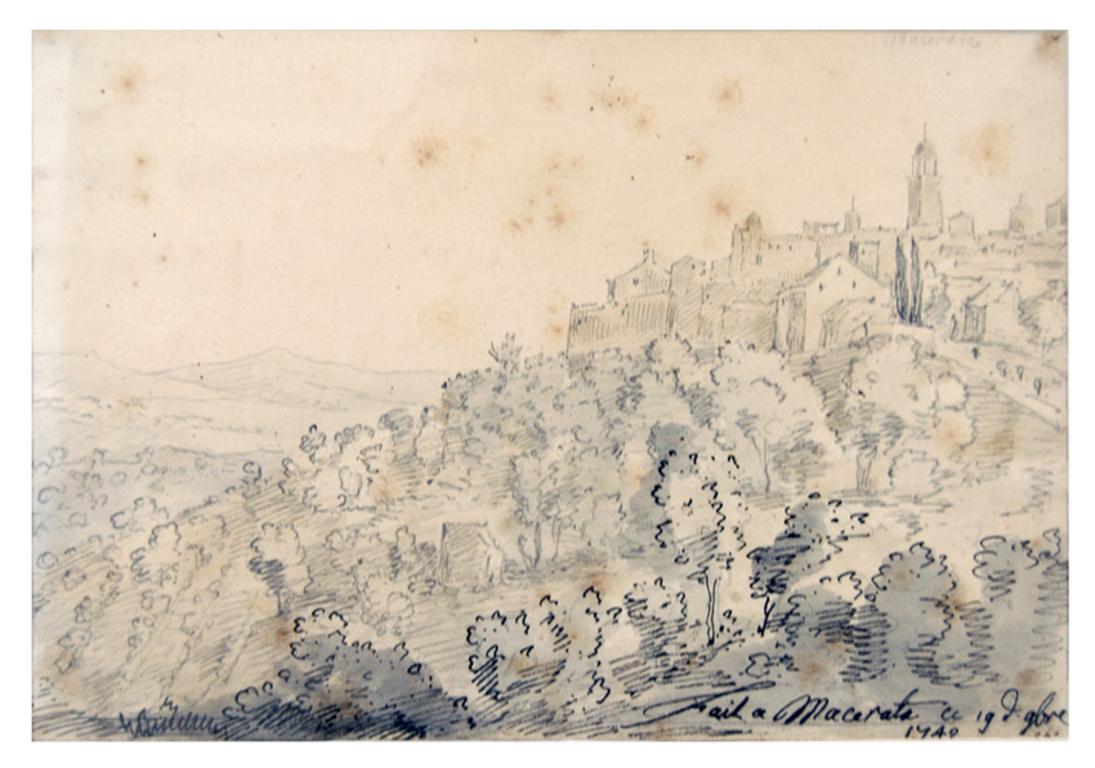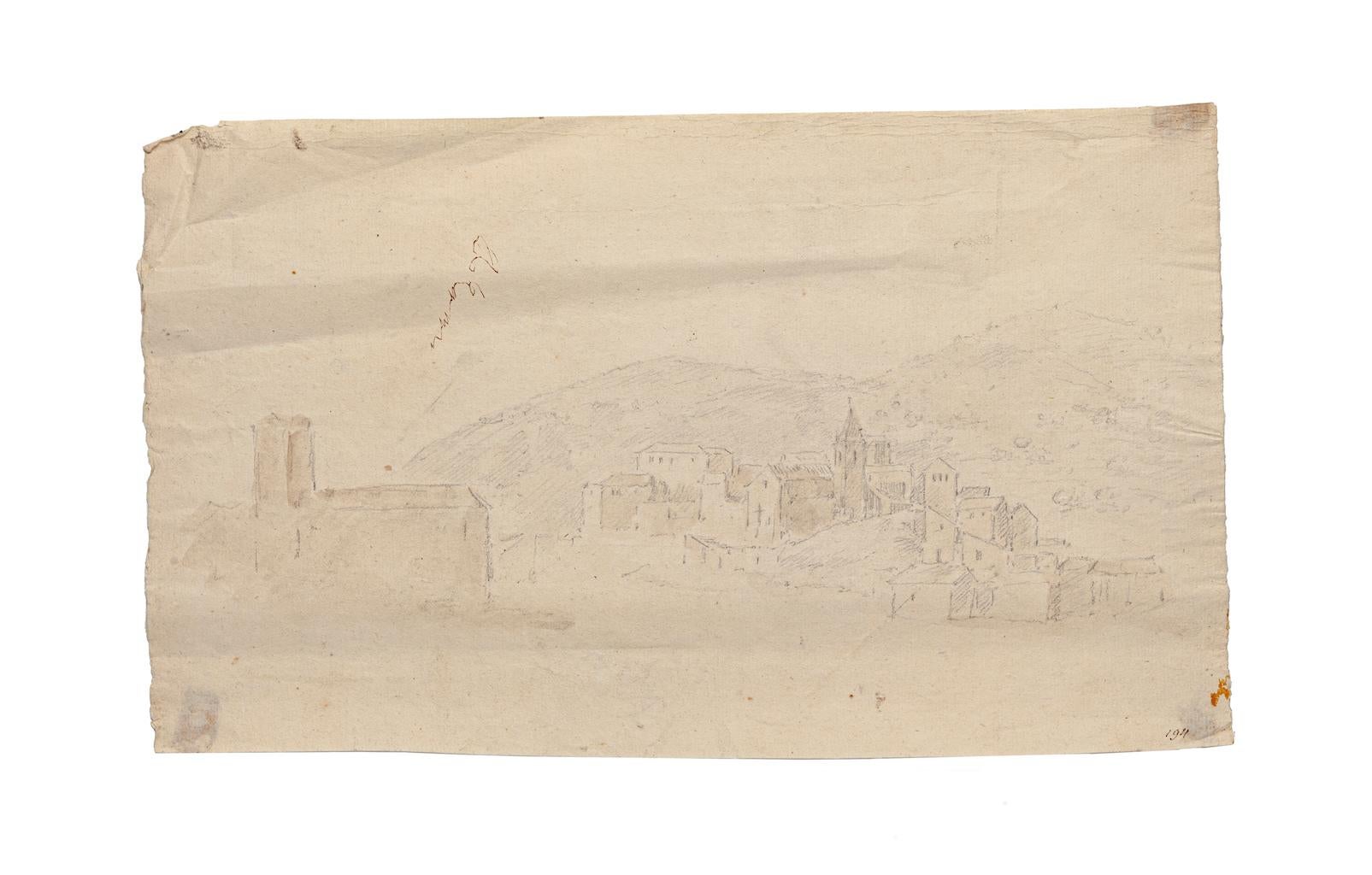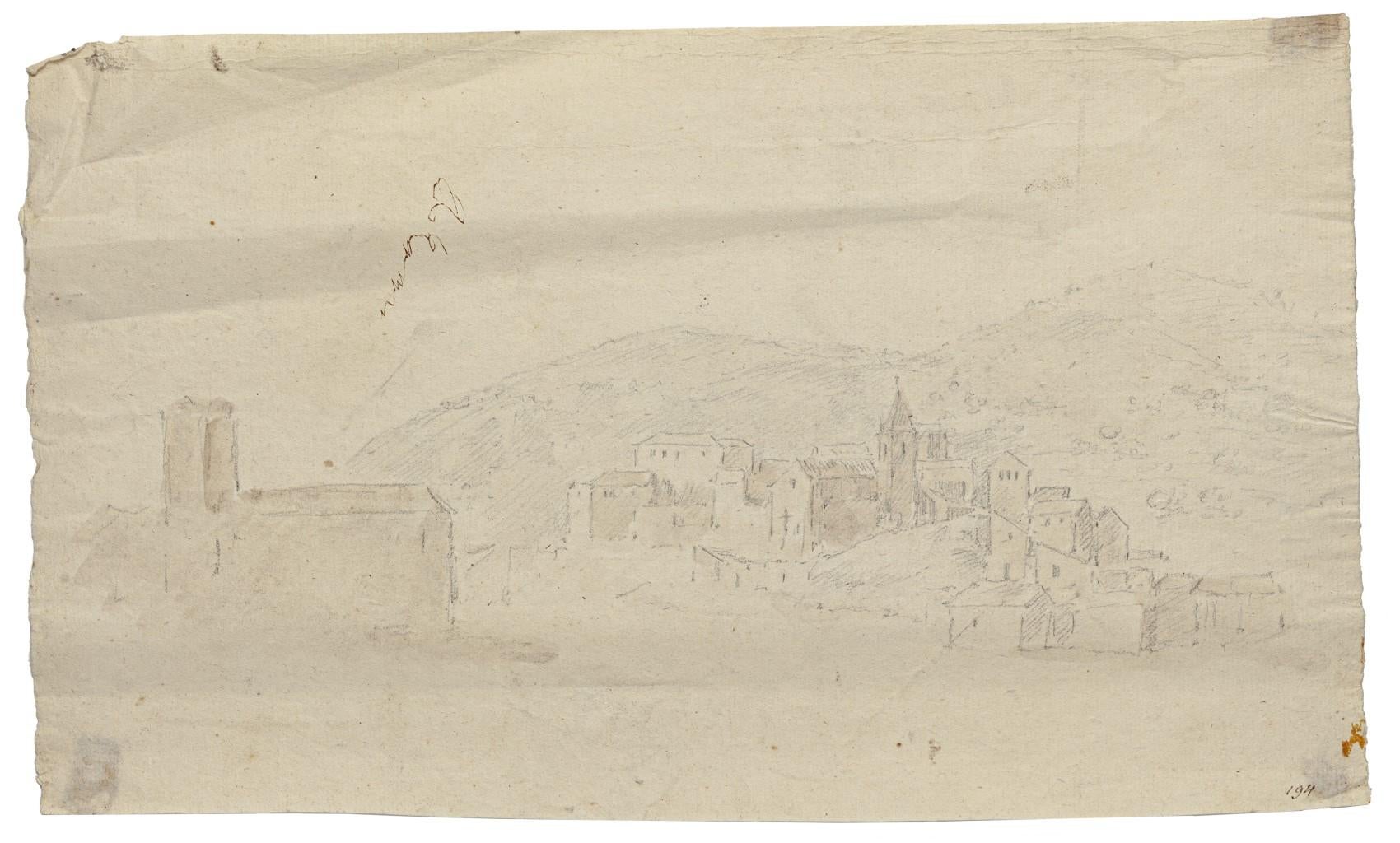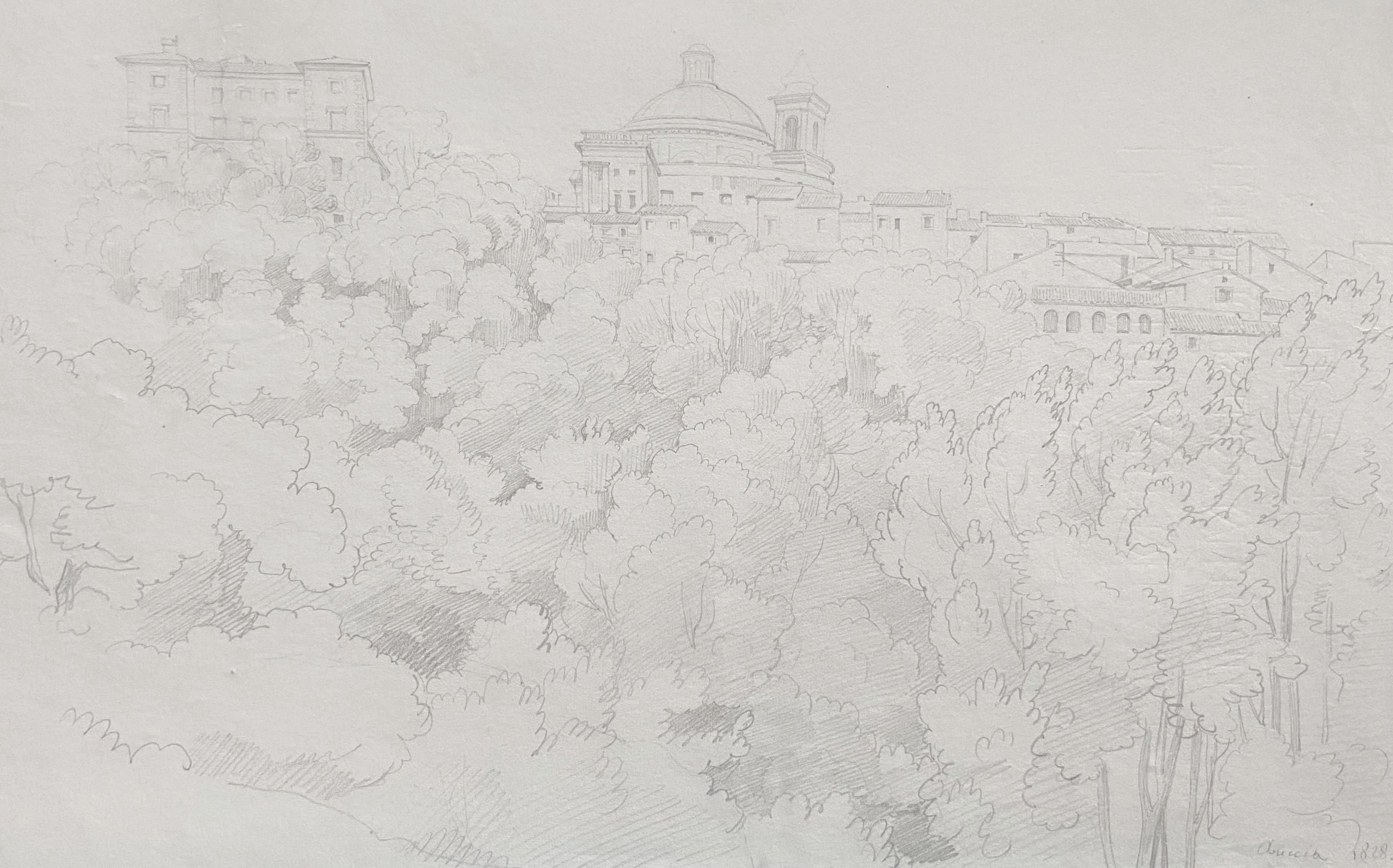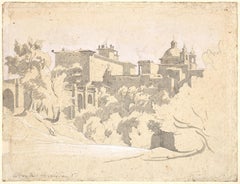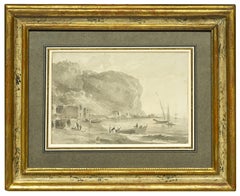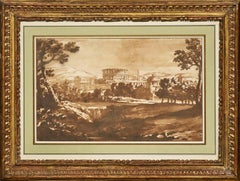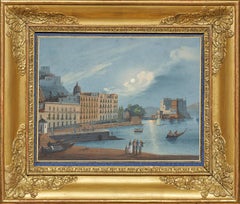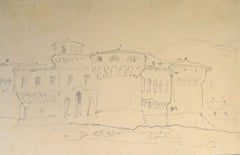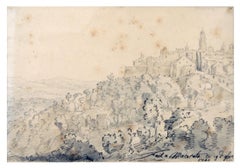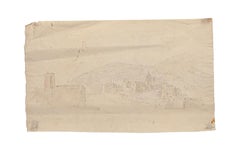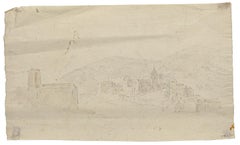Items Similar to View of a Mansion in the South of France, a drawing by Claude-Joseph Vernet
Want more images or videos?
Request additional images or videos from the seller
1 of 9
Claude-Joseph VernetView of a Mansion in the South of France, a drawing by Claude-Joseph Vernet1732-1734
1732-1734
$6,262.78
£4,630.16
€5,250
CA$8,614.37
A$9,575.40
CHF 5,019.22
MX$116,938.83
NOK 62,662.08
SEK 58,953.32
DKK 39,968.16
About the Item
We would like to thank Madame Beck-Saiello for confirming the autograph nature of this drawing after an in-person examination.
It was probably during an excursion in the countryside near Avignon that Claude-Joseph Vernet executed this drawing, enhanced with pen and brown ink, depicting a mansion on a hilltop overlooking a small village with geometric shapes.
1. Joseph Vernet, a painter influenced by Italy
Claude-Joseph Vernet was born in Avignon in 1714, the son of Antoine Vernet (1689-1753), an artisan painter of architectural decorations, coach panels, and the like. He moved to the studio of Philippe Sauvan (1697-1792), a leading history painter in Avignon, and then worked with Jacques Viali (active 1681-1745), a decorative, landscape, and marine painter in Aix-en-Provence. Vernet's first recorded paintings were decorative overdoors executed in 1731 in the Aix townhouse of the marquise de Simiane. In 1734, Joseph de Seytres, marquis de Caumont, a leading amateur in Avignon, sponsored Vernet to make a study trip to Italy to complete his artistic education and to draw antiquities for his patron.
As Avignon was a papal territory in Vernet's day, he also had a number of useful introductions among influential churchmen when he arrived in Rome. Vernet was soon at home in the French community there, and he was encouraged by Nicolas Vleughels (1668-1737), director of the Académie de France in Rome, even though the young painter had no official affiliation with the royal institution. He likely entered the studio of the French marine painter Adrien Manglard (1695-1760). By 1740 Vernet was developing an independent reputation as a painter of topographical landscape in and around Rome and Naples, as well as of imaginary Italianate landscapes and marines, demonstrated by the increasing number of entries in his surviving account books from the mid-1730s onward. His first important patron in Rome was the French ambassador Paul Hippolyte de Beauvillier, duc de Saint-Aignan (1684-1776). This relationship set a pattern, and members of the French diplomatic corps and visiting French prelates remained important patrons during Vernet's long Roman sojourn, which lasted almost twenty years (he returned definitively to France in 1753). He also worked for the Roman nobility but it was the British - the wealthiest travelers in Europe - who became Vernet's main patrons during their Grand Tours, purchasing Italianate landscapes and marines as souvenirs of their visits to Italy. The British remained enthusiastic patrons of Vernet, even long after his return to France.
The appeal of Vernet's art was twofold. On the one hand, he drew on the tradition of ideal landscape painting codified by Claude Lorrain (1604/1605-1682) and Nicolas Poussin (1594-1665) in seventeenth-century Italy. Vernet, on the other hand, brought to the study of nature a more empirical and closely observed approach, consistent with his times, creating a more vivid and convincing impression of nature. Having established these kinds of paintings as successful formulas by the mid-1740s, Vernet continued to supply a European demand for them for the rest of his career.
Vernet first exhibited typical landscapes and marines at the Paris Salon of 1746, the year his membership in the Académie royale de peinture et de sculpture was approved. He became a full member in 1753 and exhibited successfully at the Salon for the rest of his life. He had come to the attention of Louis XV's administration in 1746, and in 1753 he was finally called back to France to begin an official commission to paint large topographical views of the principal commercial and military seaports of the realm. This commission took him on an arduous itinerary, from Antibes in the south to Dieppe in the north, from 1753 until 1765, during which time he completed fifteen large paintings. Vernet's "Ports of France" (Paris, Musée du Louvre on loan to the Musée de la Marine) are among the greatest French paintings of the mid-eighteenth century, for they are both remarkable social and historical documents, full of fascinating observation, and at the same time beautifully composed and rendered works of art.
Vernet continued a large production of imaginary landscape and marine paintings until his death on the eve of the French Revolution in 1789.
2. Description of the drawing
Our drawing was probably first executed by Claude-Joseph Vernet in pencil, working on the spot and in the open air, then retouched in pen and brown ink with a lively, regular stroke once he had returned to his studio. In all likelihood, it depicts a Provencal mansion, proudly perched on a hill overlooking a small village . The absence of shadows in the landscape and the cloudless sky allow us to imagine the bright mid-day sun.
The artist pays particular attention to the representation of architectural details (battlements, machicolations at the top of the towers, etc.). He is sensitive to the articulation of the geometric volumes that make up the village houses below the castle, and to the contrast between these sharp angles and the roundness of the castle towers. The trees are soberly evoked by their foliage, a characteristic found in many of Vernet's landscape drawings.
Vernet remained faithful to the pen-and-pencil technique for his figure drawings, as can be seen, for example, in the drawing of Trois hommes autour d'une grosse pierre (Three Men around a large Stone) in the Musée du Louvre.
From the middle of his Italian sojourn, his landscape drawings were often enriched by delicate wash work, leading us to consider this drawing a youthful work, probably executed before his departure for Italy.
3. Framing
Our drawing is soberly framed in a gilded wooden moulding reminiscent of the pastel frames of the Louis XV period.
Main bibliographical references :
Léon Lagrange - Joseph Vernet - Didier & Cie 1864
Florence Ingersoll-Smouse - Joseph Vernet, Peintre de Marine - Etienne Bignou 1926
Catalog of the exhibition Joseph Vernet 1714 - 1789 - Musée de la Marine, Paris (October 15, 1976 - January 9, 1977)
Emilie Beck Saiello - Napoli e la Francia - I Pittori da paesaggio da Vernet a Valenciennes - L'erma di Bretschneider, Roma 2010
- Creator:Claude-Joseph Vernet (1714 - 1789, French)
- Creation Year:1732-1734
- Dimensions:Height: 13 in (33.02 cm)Width: 19.5 in (49.53 cm)
- Medium:
- Movement & Style:
- Period:1730-1739
- Condition:Pen and brown ink over pencil lines Dimensions : 8 5/8’’ x 15 ½” (22 x 39.5 cm) - Framed : 13’’ x 19 ½’’ (33 x 49.5 cm) Louis XV style pastel frame in moulded and gilded wood.
- Gallery Location:PARIS, FR
- Reference Number:1stDibs: LU1568216242602
About the Seller
5.0
Vetted Professional Seller
Every seller passes strict standards for authenticity and reliability
Established in 2020
1stDibs seller since 2021
10 sales on 1stDibs
Typical response time: 3 hours
- ShippingRetrieving quote...Shipping from: PARIS, France
- Return Policy
Authenticity Guarantee
In the unlikely event there’s an issue with an item’s authenticity, contact us within 1 year for a full refund. DetailsMoney-Back Guarantee
If your item is not as described, is damaged in transit, or does not arrive, contact us within 7 days for a full refund. Details24-Hour Cancellation
You have a 24-hour grace period in which to reconsider your purchase, with no questions asked.Vetted Professional Sellers
Our world-class sellers must adhere to strict standards for service and quality, maintaining the integrity of our listings.Price-Match Guarantee
If you find that a seller listed the same item for a lower price elsewhere, we’ll match it.Trusted Global Delivery
Our best-in-class carrier network provides specialized shipping options worldwide, including custom delivery.More From This Seller
View AllView of Ariccia, a preparatory drawing by Achille Bénouville (1815 - 1891)
Located in PARIS, FR
This very modern drawing presents a view of Ariccia, a small town 25 kilometres south-east of Rome. The Palazzo Chigi (in which the film-maker Luchino Visconti would film a large part of The Leopard a century later) and the adjoining church are seen from the bottom of the ravine that surrounds the town. This drawing is a moving testimony to the attraction of the city for artists of the Romantic period, who established in Ariccia a vivid artists' colony.
1. Achille Bénouville...
Category
1850s Romantic Landscape Drawings and Watercolors
Materials
Ink, Gouache, Pencil
View of the Posillipo coastline near Naples by William Marlow (1740 - 1813)
By William Marlow
Located in PARIS, FR
In this drawing, inspired by his stay in Naples in 1765, William Marlow presents us with a view of Cape Posillipo, to the west of Naples, an essential stage during the Grand Tour. Th...
Category
1760s Old Masters Landscape Drawings and Watercolors
Materials
Ink
View of an Antique City, a wash landscape by Jan de Bisschop (1628 - 1671)
Located in PARIS, FR
The attribution to Jan de Bisschop has been confirmed by the RKD with the following comment: "We base this attribution on the dark washes, the subject represented and the monogram".
...
Category
17th Century Old Masters Landscape Drawings and Watercolors
Materials
Ink, Pen
View of the Ovo Castle in the Moonlight, a 19th century Neapolitan gouache
Located in PARIS, FR
Neapolitan gouaches appeared in the eighteenth century when tourism in the Naples area was developing: the discoveries of Herculaneum and Pompeii made this city a mandatory stop on the Grand Tour, the journey made by wealthy Europeans to complete their education.
Generally small in size for ease of transport and affordable in price, these gouaches were the ideal travel souvenir that these tourists of the early days were bringing back to capture the idyllic landscapes they had discovered during their journey and to share them with family and friends upon their return at home.
The Bay of Naples and the eruptions of Vesuvius are the favourite themes of these views. Here we have a view of the Ovo Castle, which was rebuilt on the island of Partenope, in the middle of the Bay of Naples and about a hundred metres from the shore by the Normans in the 12th century on antique ruins...
Category
Early 19th Century Romantic Landscape Drawings and Watercolors
Materials
Gouache, Paper
Rocky Landscape with Trees and Temple Ruins a drawing by Giulio Parigi (ca 1615)
Located in PARIS, FR
This Rocky Landscape with Trees and the Ruins of a Temple is a drawing by Giulio Parigi, an eclectic and prolific artist of the Medici court. An engraver, architect, furniture and je...
Category
1610s Old Masters Landscape Drawings and Watercolors
Materials
Ink, Laid Paper, Pen
Study for « Paysage de Fribourg » - 1943 a drawing by Balthus (1908 - 2001)
By Balthus (Balthasar Klossowski de Rola)
Located in PARIS, FR
Provenance: Frédérique Tison, Château de Chassy (Burgundy-Franche Comté - France)
Bibliography: J. Clair, V. Monnier Balthus, catalogue raisonné of the complete works, Gallimard, Pa...
Category
1940s Modern Landscape Drawings and Watercolors
Materials
Paper, Pencil
You May Also Like
Chateau Fort - 19th Century - Horace Vernet - Drawing - Old Master
By Émile Jean-Horace Vernet
Located in Roma, IT
Chateau fort is an original pencil drawing on paper by Horace Vernet realized in XIX century. Certified by Paul Proutè. Very good conditions, except for a very little rip on the lef...
Category
19th Century Old Masters Figurative Drawings and Watercolors
Materials
Pencil
Vue de Macerata et de sa Campagne - drawing by J. P. Verdussen - 1742
By Jan Peeter Verdussen
Located in Roma, IT
China ink and watercolour on paper.
Some foxing, otherwise very good condition.
Titled and dated.
Includes passepartout.
Category
1740s Figurative Drawings and Watercolors
Materials
Ink, Watercolor
Landscape - Pencil and Watercolor by Jan Pieter Verdussen - 1750
By Jan Pieter Verdussen
Located in Roma, IT
Landscape is a beautiful drawing in watercolor and pencil on ivory-colored paper realized by Jan Peter Verdussen.
In good condition; only a smallspots at the edges of the drawing an...
Category
1750s Old Masters Figurative Drawings and Watercolors
Materials
Paper, Ink, Watercolor
Landscape - Watercolor and Pencil by Jan Peter Verdussen - 18th Century
By Jan Peeter Verdussen
Located in Roma, IT
Landscape is a beautiful dranwing in watercolor and pencil on ivory-colored paper realized by Jan Peter Verdussen.
In good condition; only a sma...
Category
18th Century Old Masters Landscape Drawings and Watercolors
Materials
Watercolor, Pencil
French Romantic School, View of Arriccia, 1828, drawing
Located in Paris, FR
French Romantic School beginning of the 19th Century
View of Arriccia, 1828
located and dated, "Arriccia 1828" on the lower right
Pencil on paper
23 x ...
Category
1820s Romantic Landscape Drawings and Watercolors
Materials
Pencil
Landscape - Drawing by Jan Peter Verdussen - 1745 ca
By Jan Peeter Verdussen
Located in Roma, IT
Landscape is a beautiful drawing in pencil and watercolor on paper realized by Jan Peter Verdussen in 1745 ca.
In good condition, excpet for some foxing on the right.
The artwork r...
Category
1740s Old Masters Landscape Drawings and Watercolors
Materials
Watercolor, Pencil
More Ways To Browse
Drawing Of A House
Large Landscape Drawing
Architectural Drawing Study
Large Architectural Drawing
Italian Architectural Drawings
French Architectural Drawings
Antique Architectural Drawings
Old Master Italian Drawings
Set Architectural Drawings
Antique Drawing Set
Claude De France
Old Master Drawings Framed
Antique View Master
Claude Home
Roman Paul
One Of A Kind Mens
Drew And Sons
Old Master Pencil Drawing
